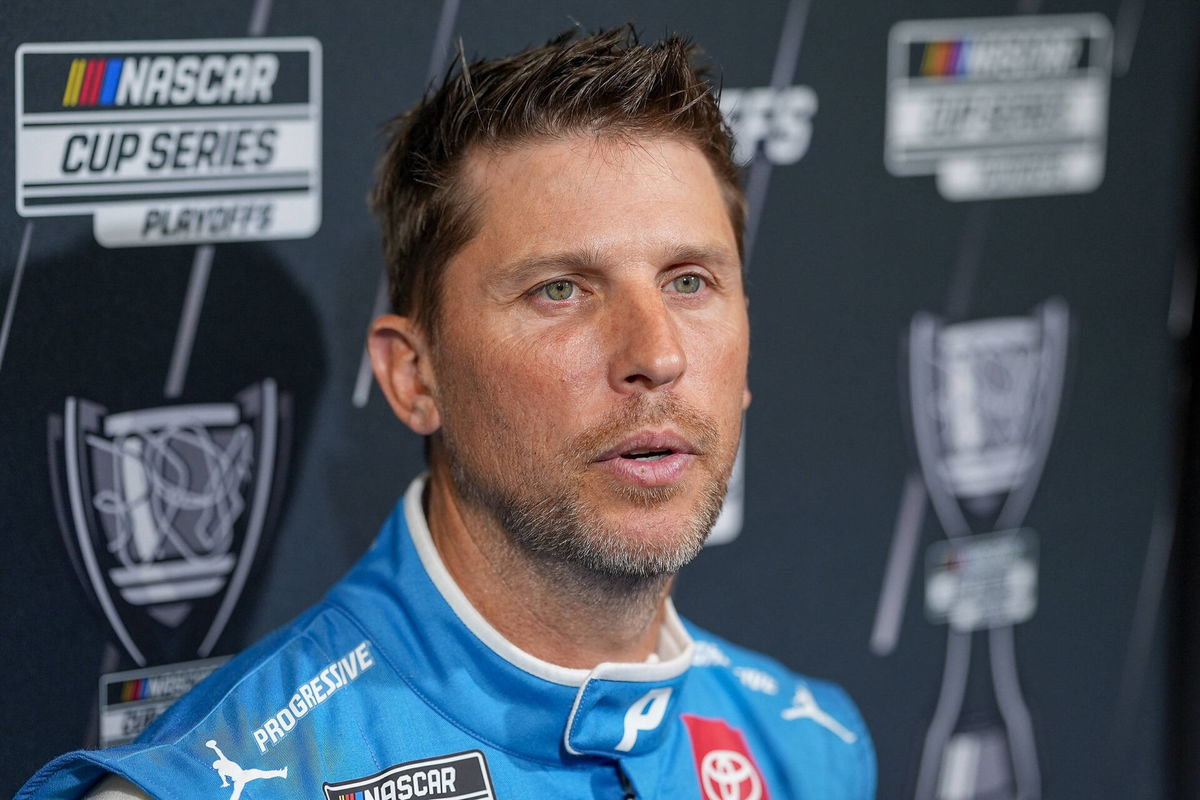
Imago
NASCAR, Motorsport, USA Cup Series Playoff Media Day Aug 27, 2025 Charlotte, NC, USA Denny Hamlin answers questions from the media during NASCAR Cup Series Playoff Media Day at Charlotte Convention Center. Charlotte Charlotte Convention Center NC USA, EDITORIAL USE ONLY PUBLICATIONxINxGERxSUIxAUTxONLY Copyright: xJimxDedmonx 20250827_jla_db2_013

Imago
NASCAR, Motorsport, USA Cup Series Playoff Media Day Aug 27, 2025 Charlotte, NC, USA Denny Hamlin answers questions from the media during NASCAR Cup Series Playoff Media Day at Charlotte Convention Center. Charlotte Charlotte Convention Center NC USA, EDITORIAL USE ONLY PUBLICATIONxINxGERxSUIxAUTxONLY Copyright: xJimxDedmonx 20250827_jla_db2_013
For over a decade, one of the most enduring images in NASCAR has been Denny Hamlin sitting devastated on the pit wall at Phoenix in 2010. That night, his championship hopes seemed certain. This was just before late-race fuel strategy issues unraveled his campaign. By the time the series reached Homestead, Jimmie Johnson secured his fifth straight title. Meanwhile, Hamlin’s first Cup crown slipped away. That moment left Hamlin visibly shaken. His body language conveyed the crushing weight of lost opportunity. Now, nearly 15 years later, Hamlin has revisited that memory with a fresh perspective. One that highlights his growth as a driver and as a person.
Watch What’s Trending Now!
The Phoenix heartbreak marked a turning point for Hamlin. It shaped how the NASCAR world viewed him and how he came to view himself. It forced him to confront the mental strain of competing at the highest level. This was a challenge he later admitted had nearly consumed him. After all, his maiden championship title has eluded him to this day. Working with sports psychologist Bob Rotella in the years after helped him better handle pressure. But the scars of 2010 still linger. And that lingering disappointment is what makes Hamlin’s recent admission so compelling, one when he first learned that mental survival in NASCAR depends on more than speed or strategy.
ADVERTISEMENT
Denny Hamlin’s mental health mantra
Recently, Denny Hamlin was asked about the young Hamlin sitting on the wall at Phoenix back in the day, and how he compares to today’s version of himself. Hamlin acknowledged that the pain of that Phoenix loss would still be real. “If the same thing happened today, I would still be very disappointed,” he said. What has changed is his understanding of control. “What I didn’t understand in that moment was that it wasn’t something I controlled. It was very unfortunate. We went from essentially locking up the championship to unfortunately losing it the next week.” For Hamlin, experience has taught him that channeling disappointment into perspective is the only way to maintain balance in a career defined by constant ups and downs.
The veteran went further. He outlined the guiding philosophy that keeps him grounded. “I’ve become more content being disappointed about the things I can control versus the things I can’t, and that’s certainly put me in a much better headspace as I’ve gotten older.” This reflects that Hamlin now channels his frustration into areas where he actually has control, as compared to the things he can’t. He added, “Your mental health can’t survive being angry all the time. You have to appreciate the little victories, do the best you can, and be okay with that. Wherever the result ends up, it is what it is.”
This shows that instead of dwelling on frustrations, Hamlin has learned to shift focus toward consistency and celebrating small wins like strong finishes, stage victories, or team execution. NASCAR is an unpredictable sport as there are many factors outside the driver’s control. So Hamlin’s point is that obsessing over those negatives can take a toll on anybody’s mental energy and performance. Appreciating the positives, though small, is the only way to stay sane and mentally healthy to survive long-term in the competition.
ADVERTISEMENT
POLE for the #Southern500!!@dennyhamlin will start P1 tomorrow!#TeamToyota | @SportClips pic.twitter.com/i9iFhaSFXR
— Joe Gibbs Racing (@JoeGibbsRacing) August 30, 2025
Looking ahead, the question is whether Hamlin’s evolved mindset can finally deliver Cup Series success as he sits at pole position ahead of Darlington. His legacy already features 58 Cup wins and three Daytona 500s. These are achievements that would place him in NASCAR’s Hall of Fame regardless of titles. Today, he continues leading both on the track and as co-owner of 23XI Racing. Regardless of a championship, Hamlin’s new philosophy will ensure a collected approach as the 2025 playoffs are set to begin.
ADVERTISEMENT
Hamlin steps back amidst growing playoff tension
As the NASCAR Cup Series heads into the playoff stretch, tensions and strategies are under a microscope. Within 23XI Racing, the spotlight is on how co-owner Denny Hamlin navigates his dual role — a competing driver and a team boss. Recently at Darlington, Hamlin revealed a calculated approach. This helped him maintain fairness among his teammates, Bubba Wallace and Tyler Reddick, during this critical phase. This balancing act hints at a deeper leadership play that protects his competitive edge.
Hamlin recently admitted he deliberately distances himself from team strategy sessions during the ten playoff races. “I give them a little bit of space during the playoffs… Nothing would anger me more than to give them a secret of mine and then it knocks me out of the playoffs,” he said, highlighting the importance of fairness and integrity in his approach.
ADVERTISEMENT
Reddick reinforced the separation between their professional roles. He noted, “On the track, we race each other as if he’s not my owner and I’m not his driver.” That balance of respect and rivalry shows how 23XI has managed to maintain competitive credibility while juggling complicated relationships.
Looking ahead, Hamlin’s restraint could set a precedent for other owner-drivers in NASCAR. By pulling back at the right moments, he not only avoids conflicts within his team but also ensures that Wallace, Reddick, and he can chase postseason success on equal footing.
ADVERTISEMENT
ADVERTISEMENT
ADVERTISEMENT

